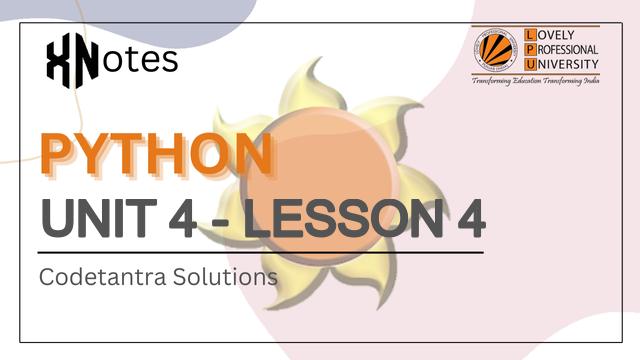Unit 4 - Lesson 4 | Codetantra Python

Unit 4 - Lesson 4
37.1.1. Understand the List Operations
(a)l1 = [1, 20, 30, 40] index of l1 starts from 0.
37.1.2. Create and access a List
# write your code here
b = input("data: ").split(',')
print('list:',b)
a=int(input("index: "))
try:
print('element:',b[a])
except:
print('invalid')
37.1.3. Write a program to find whether a given element exists in a list or not
x = input("data: ")
y = input("element: ")
print(y in x)
37.1.4. Write a Program to print the first and last elements of a List.
x = input("data: ")
x = x.split(',')
print("first, last elements:", x[0],x[-1])
37.1.5. Understanding List slicing
input_str = input("Enter a list of numbers separated by spaces: ")
# Convert input string into a list of integers
a = []
b= input_str.split(' ')
for i in b:
if i != " ":
a.append(int(i))
# Get user inputs start,stop and step for slicing parameters
s = int(input("start index: "))
e = int(input("stop index: "))
v = int(input("step value: "))
# Create a new list using slicing
# Display the sliced list
print("Sliced List:",a[s:e:v])
37.1.6. Write a program to print True as output if the first or last element of a List is 3 otherwise print False
i = input("data: ")
#a = i.split[',']
if i[0] == "3" or i[-1] == "3":
print(True)
else:
print(False)
37.1.7. Understanding List Repetition and Concatenation
# write your code here
x = input("data1: ")
y = input("data2: ")
n = int(input("num: "))
x = x.split(",")
print(x*n)
y = y.split(",")
print(y*n)
print("extending list1 with list2:", x+y)
37.1.8. Understanding list comparison
x = input("data1: ")
y = input("data2: ")
l1 = []
l2 = []
x = x.split(',')
y = y.split(',')
print("is equal:",x == y)
print("is not equal:", x != y)
37.1.9. Write a program to print EQUAL if first and last elements of a list are same otherwise print NOT EQUAL
x = input("data: ")
x = x.split(',')
if x[0]==x[-1]:
print("equal")
else:
print("not equal")
37.1.10. Understanding Mutability in Lists
# write your code here
x = input("data: ")
x = x.split(",")
print("before updation:", x)
i = int(input("index: "))
if len(x) <= i or -len(x) >=i:
print("invalid")
else:
e = input("element: ")
x[i] = e
print("after updation:",x)
37.1.11. Write a Program to find the largest of the first and last elements of a List
x = input("data: ")
x = x.split(',')
g = 0
l= []
for i in x:
l.append(int(i))
print(l)
print("largest among first, last elements:", end=" ")
if x[0]>x[-1]:
print(x[0])
else:
print(x[-1])
37.1.12. Understanding List aliasing
# write your code here
list1 = list(input("data: ").split(','))
list2 = list1
print("list1 is list2:",list1 is list2)
print("list2 is list1:",list2 is list1)
i = int(input("index: "))
if len(list1)>=-i and len(list1)>i:
#if i<len(list1) and i>=-len(list1):
z = input("element: ")
list1[i] = z
print("list1 is list2:", list1 is list2)
print("list2 is list1:", list2 is list1)
else:
print("enter valid index")
37.1.13. Understanding List Cloning
# write your code here
x = input("Enter a list of numbers separated by spaces: ")
l=[]
for i in x.split(' '):
l.append(int(i))
print("Original List:", l)
a = l[:]
a[0]=100
print("Cloned List (Slicing):", a)
b= list(l)
b[1] = 200
print("Cloned List (list() Function):",b)
c = l.copy()
c[2] = 300
print("Cloned List (copy() Method):",c)
37.1.14. Write a program to check whether the first and last elements of two given Lists are same or not
x = input("data1: ").split(",")
y = input("data2: ").split(",")
if (x[0]==y[0]) or (x[-1] == y[-1]):
print("True")
else:
print("False")
37.1.15. Understanding and implementing deletion operations on elements in a list.
# Warning: Use spaces to indent the functions or it will give Indentation Error
initial_input = input("Enter elements: ")
my_list = initial_input.split()
print("Current List: ", my_list)
def delete_elements_del():
index = int(input("Enter the index to delete an element: "))
# Check if the index is valid or not
try:
# Delete element at the specified index using 'del'
del my_list[index]
print("Updated list: ", my_list)
except:
print("Invalid index")
def delete_elements_remove():
element_to_remove = input("Enter an element to remove: ")
# Check if element is in the list or not
if element_to_remove in my_list:
# Remove the element using 'remove()' method
my_list.remove(element_to_remove)
print("Updated list: ", my_list)
else:
print("Element not found")
def delete_elements_pop():
index = int(input("Enter an index to pop an element: "))
# Check if the index is valid or not
try:
# Pop element at the specified index using 'pop()' method
print("Popped element: ",my_list.pop(index))
print("Updated list: ", my_list)
except:
print("Invalid index")
def clear_list():
# Clear the list using 'clear()' method
my_list.clear()
print("Cleared list: ", my_list)
# Performing operations one by one
delete_elements_del()
delete_elements_remove()
delete_elements_pop()
clear_list()
print("Exiting the program")
37.1.16. Write a program to remove all the duplicates from a List.
# write your code here
x = input("data: ").split(',')
print(x)
l=[]
for i in x:
if i not in l:
l.append(i)
print("after removing duplicates:",l)